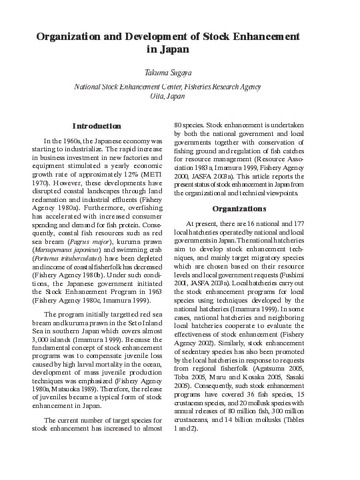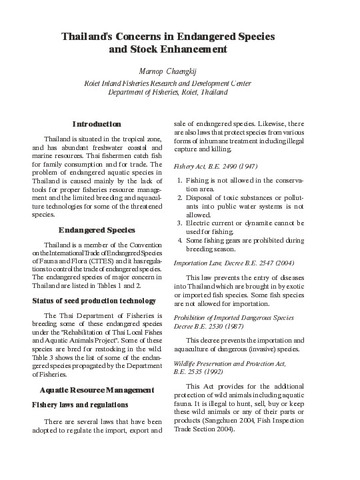Aquaculture-based Enhancement and Restoration of Giant Clam in Thailand
Share
trừu tượng
Giant clams are protected species under Thailand's Wildlife Conservation and Protection Act of B.E. 2535. Natural stock of giant clams has been declining to scarcity in almost every natural distribution area. Among three living giant clam species in Thai waters, Tridacna squamosa was considered the most endangered with less than 1% in existing number. Successful hatchery breeding and seed production of this species has been achieved by Thailand Department of Fisheries since 1993. After that, the giant clam restocking programs have been carried out at several sites both in the Gulf of Thailand and the Andaman Sea with various levels of success. Unlike other fisheries resources, the giant clam seed production and restocking in Thailand have been targeted mainly for conservation purposes. The restocking programs were cooperated by Department of Fisheries and Department of Marine and Coastal Resources. The activities have been conducted in collaboration with local communities, private sectors, as well as conservationists. Details on methodology, constraints, and results will be presented and discussed.
Suggested Citation
Nugranad, J., & Kittiwattanawong, K. (2016). Aquaculture-based enhancement and restoration of giant clam in Thailand. In H. Kawamura, T. Iwata, Y. Theparoonrat, N. Manajit, & V. T. Sulit (Eds.), Consolidating the Strategies for Fishery Resources Enhancement in Southeast Asia. Proceedings of the Symposium on Strategy for Fisheries Resources Enhancement in the Southeast Asian Region, Pattaya, Thailand, 27-30 July 2015 (pp. 171-173). Samutprakan, Thailand: Training Department, Southeast Asian Fisheries Development Center.
Chủ thể
resource management  ; stocking (organisms)
; stocking (organisms)  ; refuges
; refuges  ; resource conservation
; resource conservation  ; fishermen
; fishermen  ; food security
; food security  ; habitat loss
; habitat loss  ; fishery resources
; fishery resources  ; artificial reefs
; artificial reefs  ; habitat improvement (biological)
; habitat improvement (biological)  ; fish kill
; fish kill  ; socioeconomic aspects
; socioeconomic aspects  ; depleted stocks
; depleted stocks  ; Environmental effects; stocks
; Environmental effects; stocks  ; reproduction
; reproduction  ; breeding stock
; breeding stock  ; Cambodia
; Cambodia
 ; stocking (organisms)
; stocking (organisms)  ; refuges
; refuges  ; resource conservation
; resource conservation  ; fishermen
; fishermen  ; food security
; food security  ; habitat loss
; habitat loss  ; fishery resources
; fishery resources  ; artificial reefs
; artificial reefs  ; habitat improvement (biological)
; habitat improvement (biological)  ; fish kill
; fish kill  ; socioeconomic aspects
; socioeconomic aspects  ; depleted stocks
; depleted stocks  ; Environmental effects; stocks
; Environmental effects; stocks  ; reproduction
; reproduction  ; breeding stock
; breeding stock  ; Cambodia
; Cambodia
Related items
Showing items related by title, author, creator and subject.
-
Organization and development of stock enhancement in Japan
Sugaya, Takuma (Aquaculture Department, Southeast Asian Fisheries Development Center, 2006)In the 1960s, the Japanese economy was starting to industrialize. The rapid increase in business investment in new factories and equipment stimulated a yearly economic growth rate of approximately 12% (METI 1970). However, ... -
Thailand's concerns in endangered species and stock enhancement
Chaengkij, Marnop (Aquaculture Department, Southeast Asian Fisheries Development Center, 2006)The paper provides a comprehensive list of endangered freshwater, brackishwater, and marine aquatic species in Thailand. The Thai Department of Fisheries is breeding some of the endangered species under the “Rehabilitation ... -
SEAFDEC/AQD stock enhancement initiatives: Release strategies established
Lebata-Ramos, Ma. Junemie Hazel; Doyola-Solis, Ellen Flor; Sibonga, Rema; Sumbing, Joemel G.; Abroguena, Jeff Bogart; Santillan, August; Dimzon, Mark (Training Department, Southeast Asian Fisheries Development Center, 2016)SEAFDEC/AQD's Stock Enhancement Program started in 2001 with the first stock enhancement initiative on mud crab Scylla spp. funded by the European Commission. This was followed by another stock enhancement program in 2005 ...




